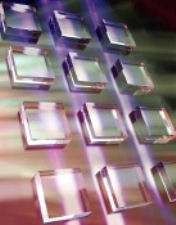Element Six, the world leader in synthetic diamond supermaterials and member of the De Beers Group of Companies, today announced that the University of Strathclyde has successfully demonstrated two notable high-power laser research developments—the first ever tunable diamond Raman laser and the first continuous-wave (CW) laser—both using Element Six's synthetic diamond material. These two achievements prove diamond's viability as a material for solid-state laser engineering, even in the most demanding intracavity applications.
 High purity single crystal CVD diamond engineered by Element Six and used by the University of Strathclyde to advance solid state laser technology. (PRNewsFoto/Element Six)
High purity single crystal CVD diamond engineered by Element Six and used by the University of Strathclyde to advance solid state laser technology. (PRNewsFoto/Element Six)
Founded in 1796 in Glasgow, Scotland, the University of Strathclyde began its laser research prior to the formation of a dedicated Institute of Photonics in 1996. In 2006, the University sought to partner with Element Six, the only company capable of providing the high optical quality material demanded by high-power lasers, in an effort to further enhance its high-power laser research. Synthetic diamond was selected for the material's unique properties, including very high thermal conductivity and transparency over a very broad range of wavelengths.
"Although continuously operating and tunable Raman lasers have been demonstrated in the past with other materials, these materials have very poor thermal conductivity, which severely limited the output powers that could be generated. Diamond removes this barrier and has paved the way for multi-watt output powers at wavelengths that are difficult to generate with conventional lasers," said Senior Research Fellow, Alan Kemp, Ph.D., who, with Research Team Leader Jennifer Hastie, Ph.D., and Professor Martin Dawson, leads this work at the University of Strathclyde's Institute of Photonics. "The successful demonstration of a diamond Raman laser indicates that diamond is now a viable material for solid-state laser engineering even in the most demanding applications. It is this potential that we hope to exploit in the future in continued partnership with Element Six."
The university achieved Raman laser operation by placing Element Six synthetic diamond within the cavity of another laser. Because Element Six synthetic diamond has very low optical loss, the university was able to demonstrate the first continuously operating diamond Raman laser, without the requirement for high intensity pulsed laser light. This is important for applications that require the precision of a continuously operating laser, rather than the substantial power of a pulsed laser, such as spectroscopic detection of trace gases and some demanding medical procedures, such as ophthalmic surgery.
The university used a tunable semiconductor disk laser to achieve tuning of the Raman laser color. This laser was also cooled using a single crystal diamond heat spreader from Element Six, allowing it to generate multiple watts of tunable output power; then, a second piece of diamond was inserted into this laser, thus demonstrating the first ever tunable diamond Raman laser.
"It has been our pleasure to partner with a leading research organization such as the University of Strathclyde for 8 years, in pursuit of this significant development," said Adrian Wilson, head of the Technologies division at Element Six. "It's very fulfilling to see that the unique low loss and low birefringence of Element Six synthetic diamond are vital in helping the university achieve these results. We have only scratched the surface as it relates to high-optical quality diamond in solid-state laser engineering, and we look forward to continuing our partnership with the University of Strathclyde to explore synthetic diamond's potential for future applications such as these."
If you're interested in learning more about these research developments in conjunction with the University of Strathclyde, or synthetic diamond's diverse properties and applications, please visit www.e6.com/optical.
About Element Six
Element Six is a synthetic diamond supermaterials company. Element Six is a member of the De Beers Group of Companies, its majority shareholder. Element Six designs, develops and produces synthetic diamond supermaterials, and operates worldwide with its head office registered in Luxembourg, and primary manufacturing facilities in China, Germany, Ireland, Sweden, South Africa, U.S. and the U.K.
Element Six supermaterial solutions are used in applications such as cutting, grinding, drilling, shearing and polishing, while the extreme properties of synthetic diamond beyond hardness are already opening up new applications in a wide array of industries such as optics, power transmission, water treatment, semiconductors, sensors and quantum information processing.
About The University of Strathclyde
The University of Strathclyde is a leading international technological university which is recognized for strong research links with business and industry, commitment to enterprise and skills development, and knowledge sharing with the private and public sectors. The University was named UK University of the Year in the 2012 Times Higher Education (THE) Awards. In the 2013 THE Awards, the University was named Entrepreneurial University of the Year.